
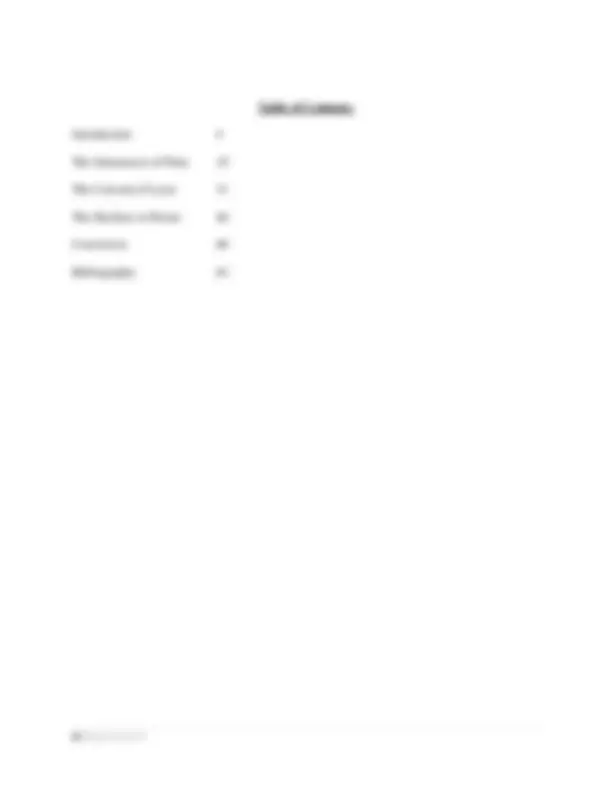
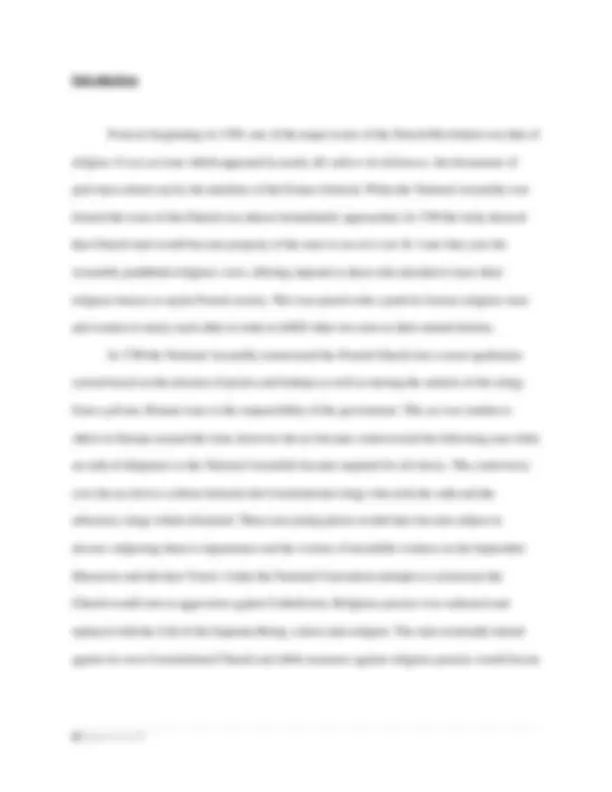
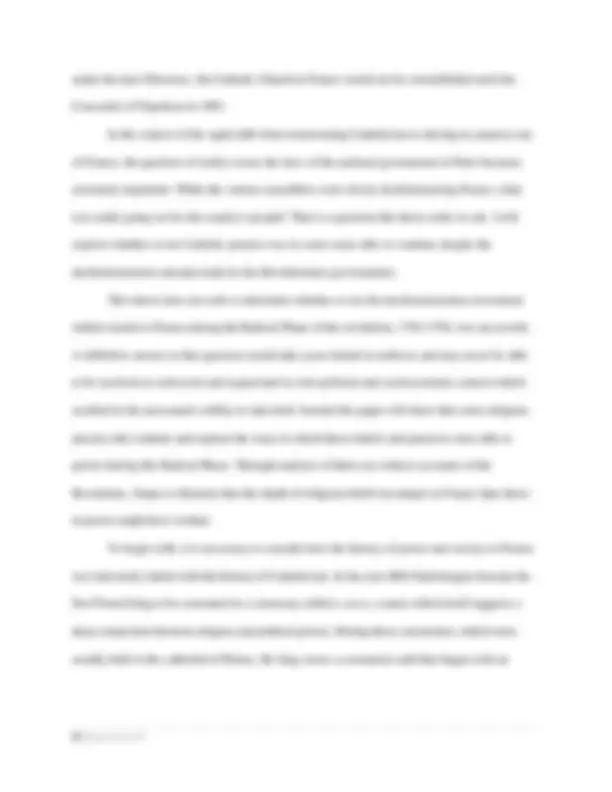
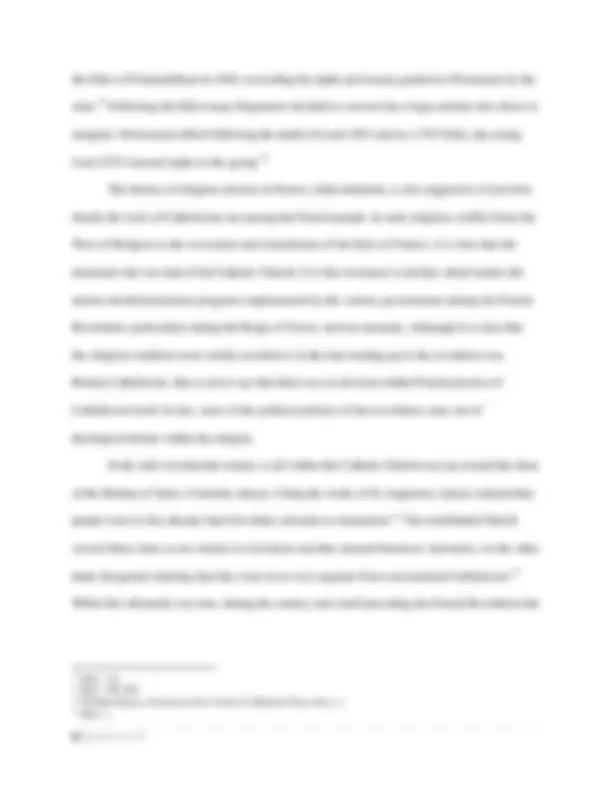
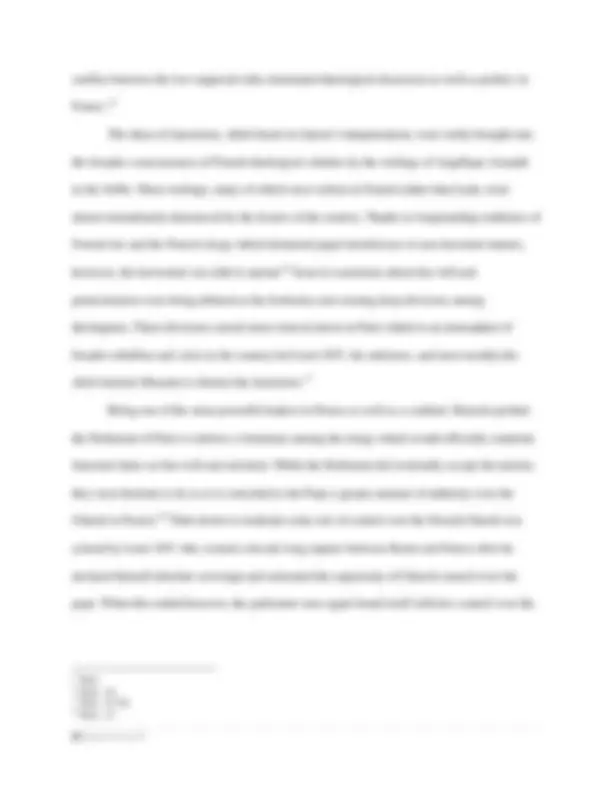
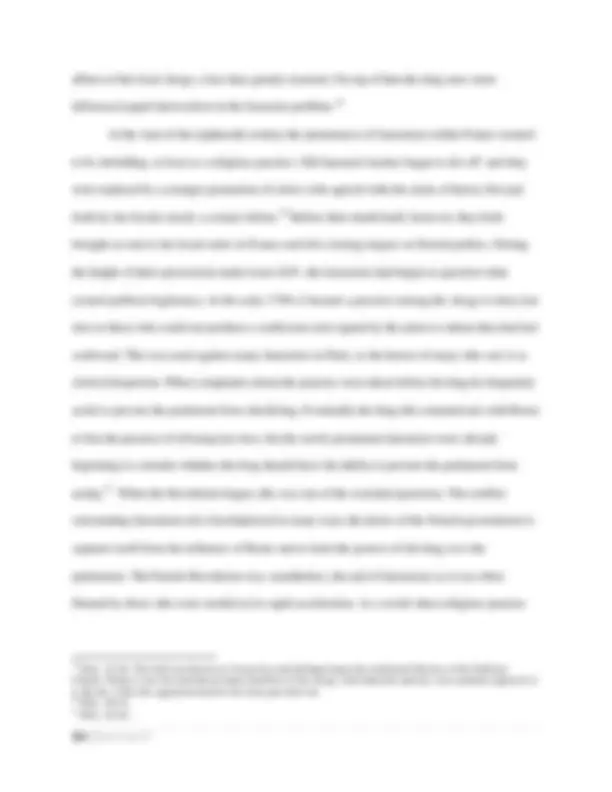
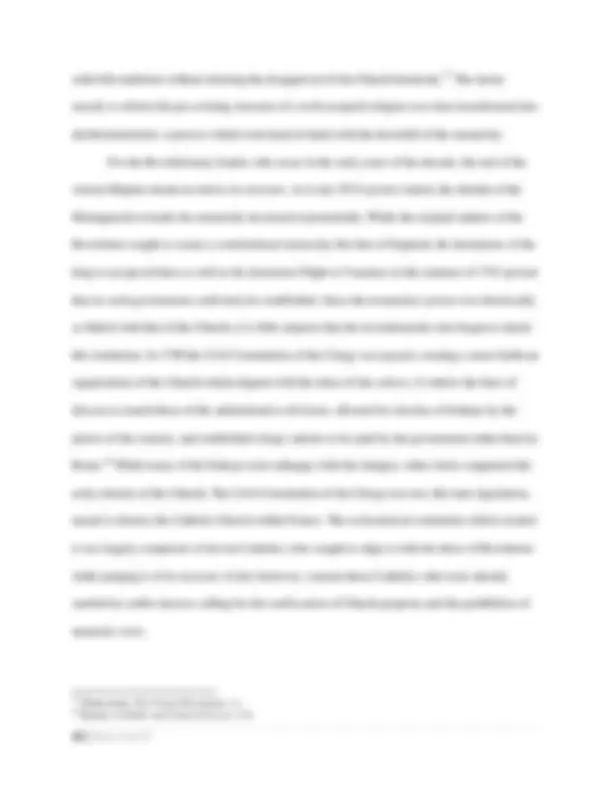
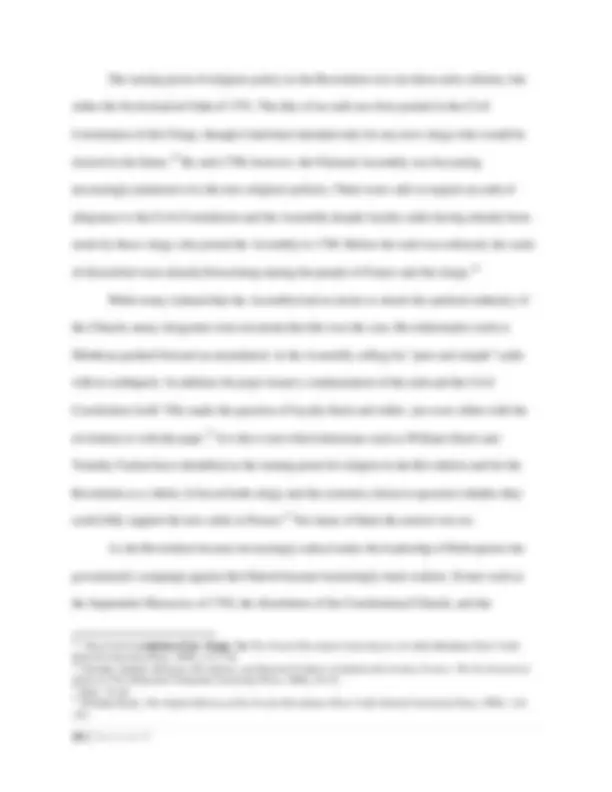
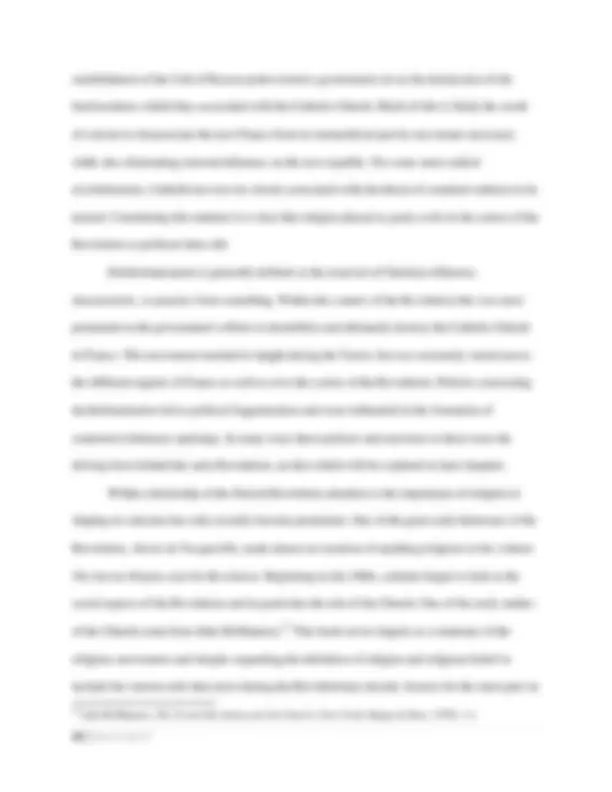
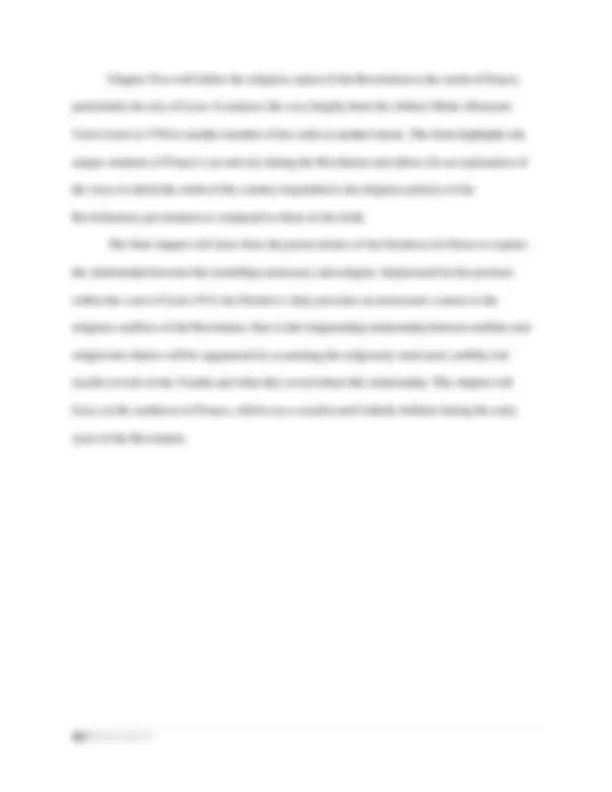
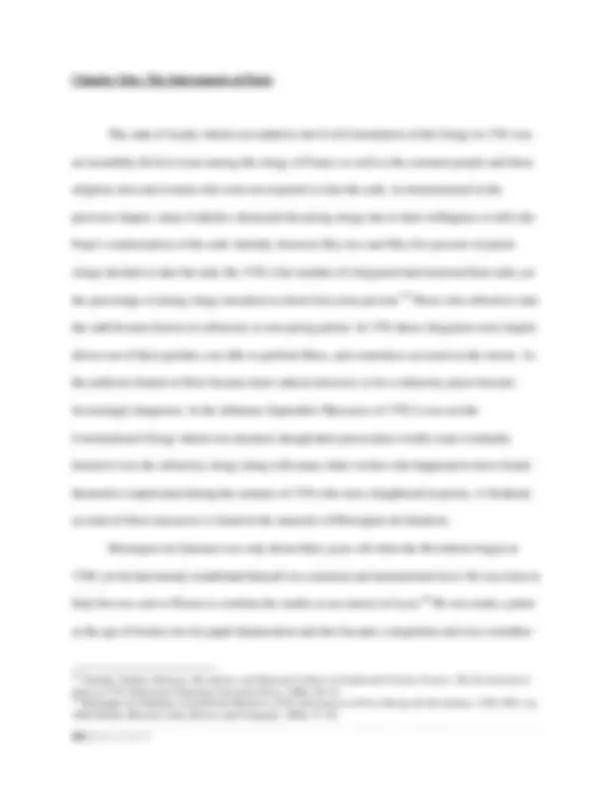
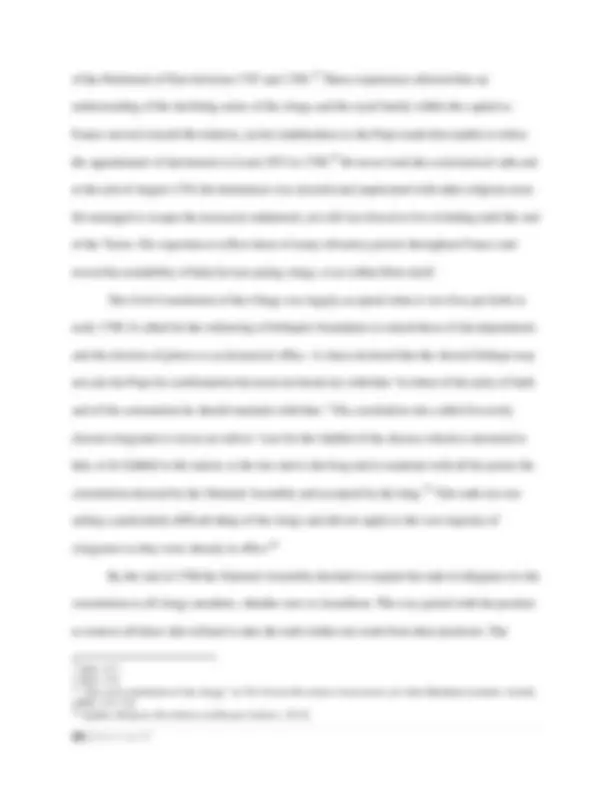
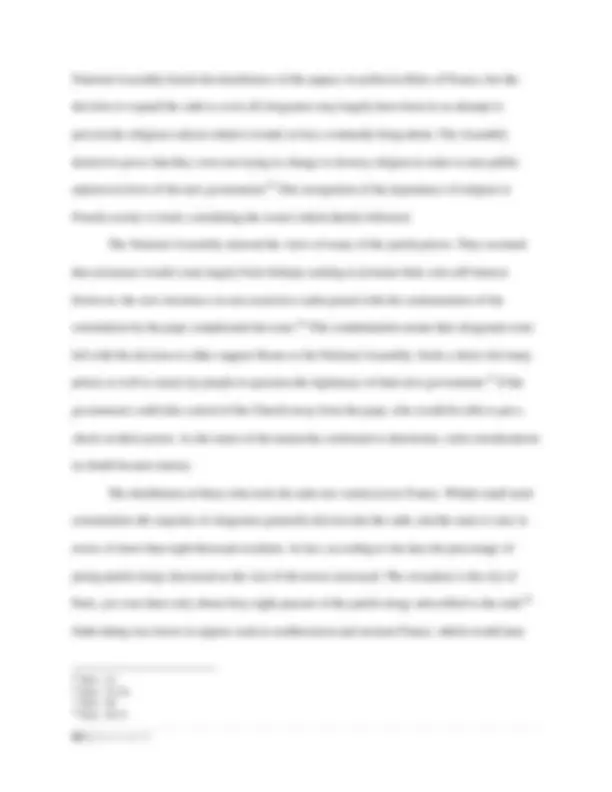
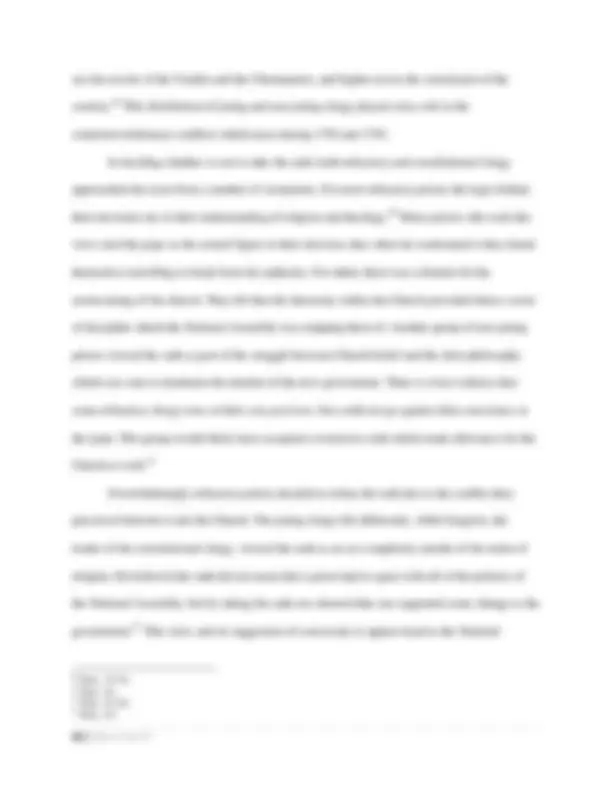
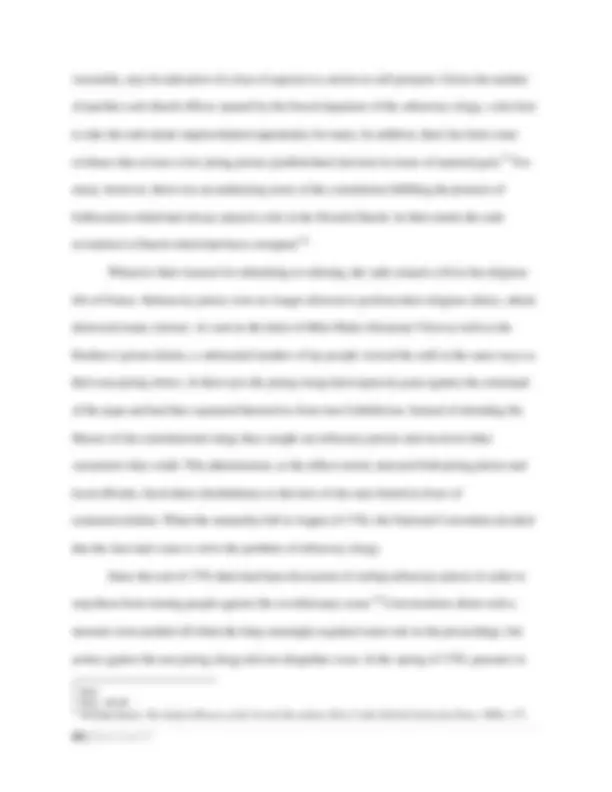
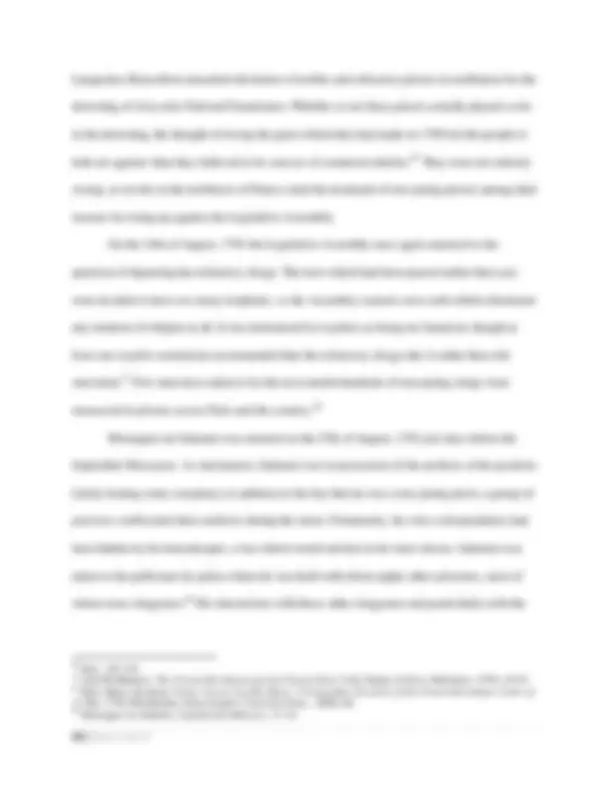
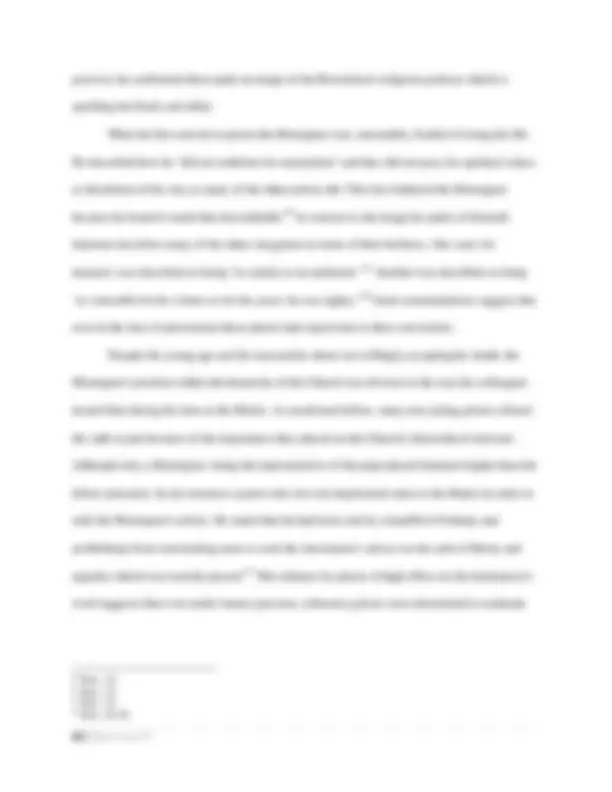
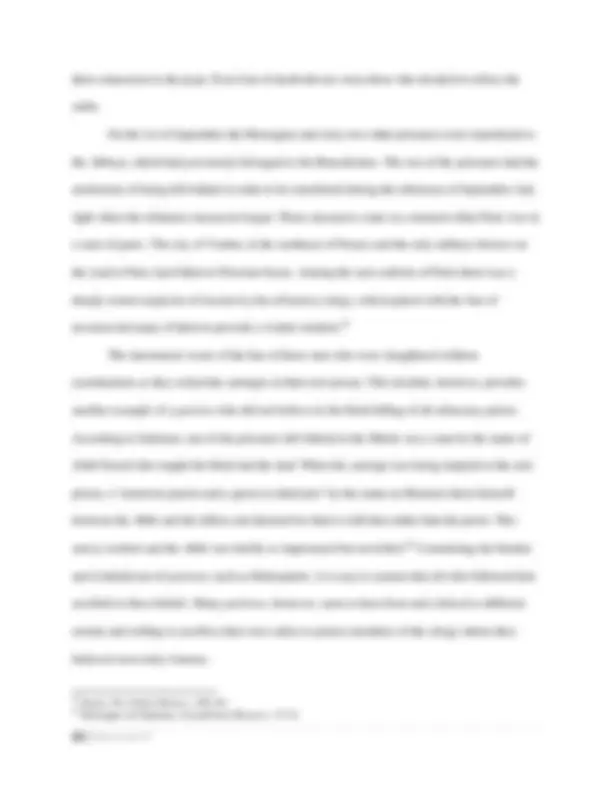
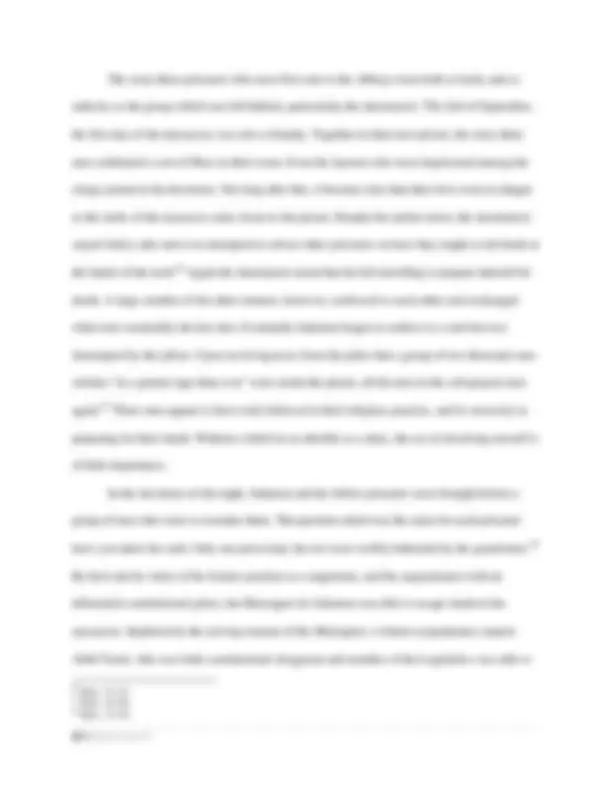
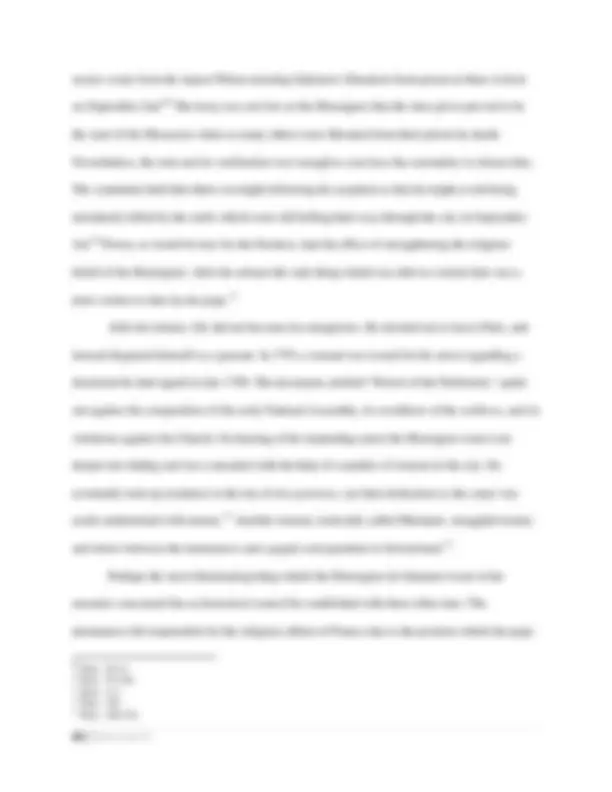
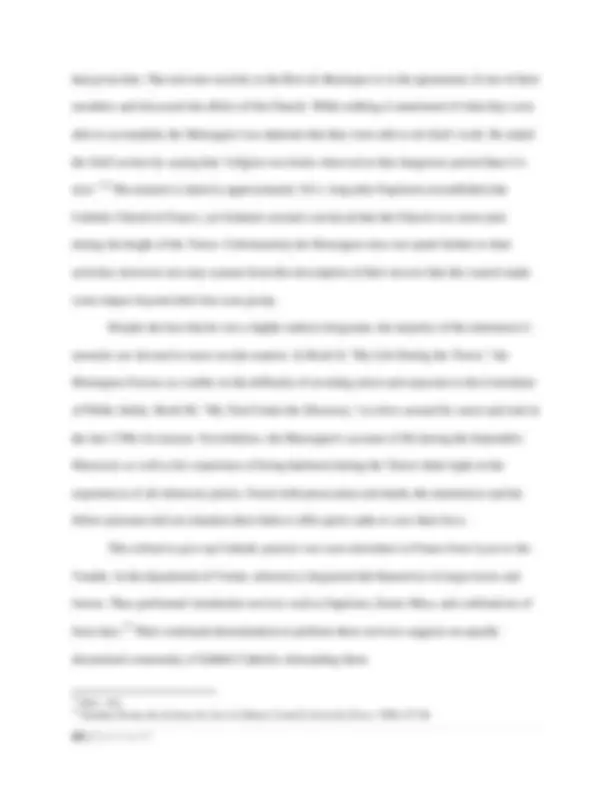
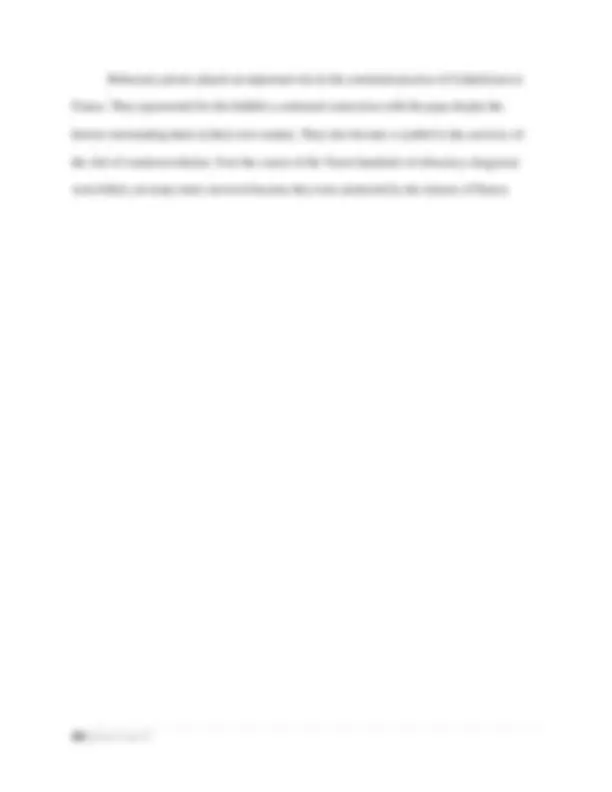
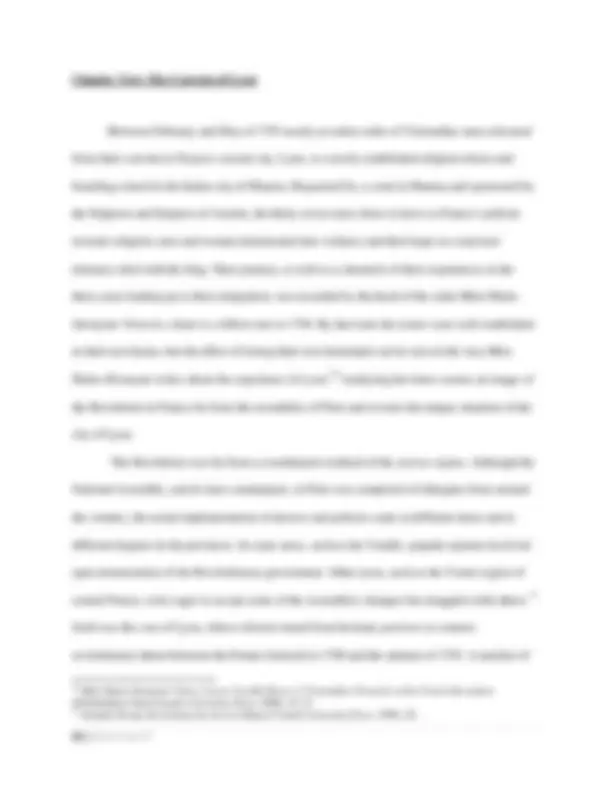
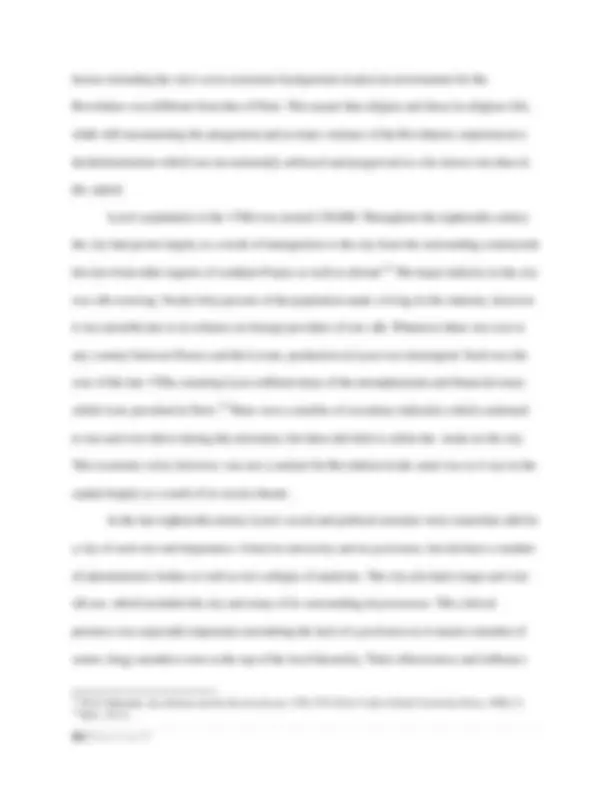
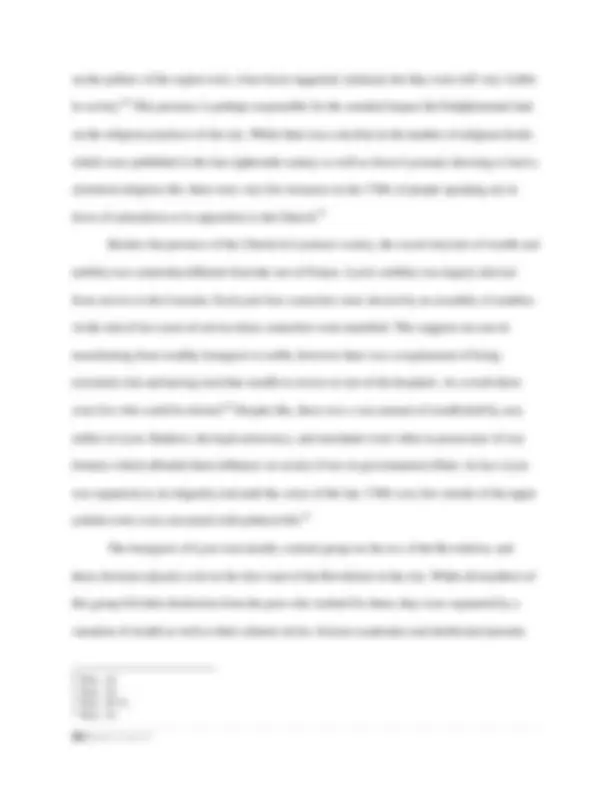
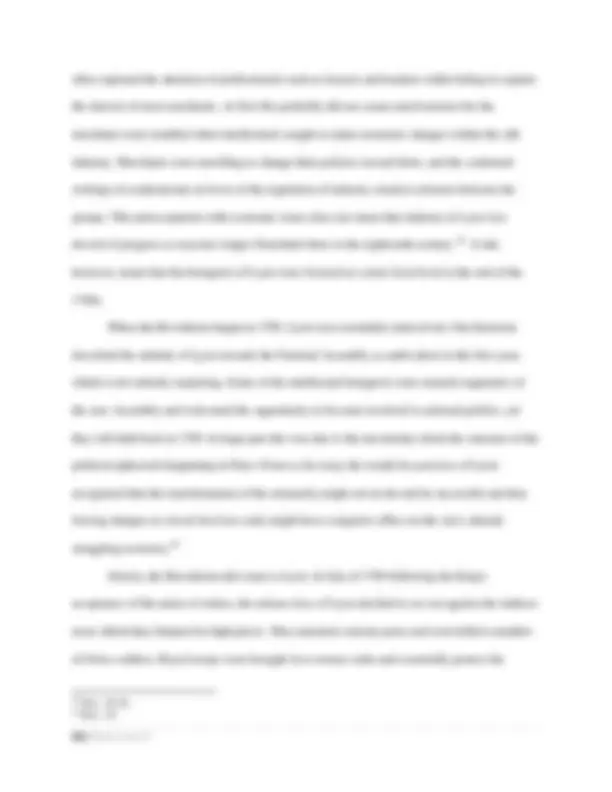
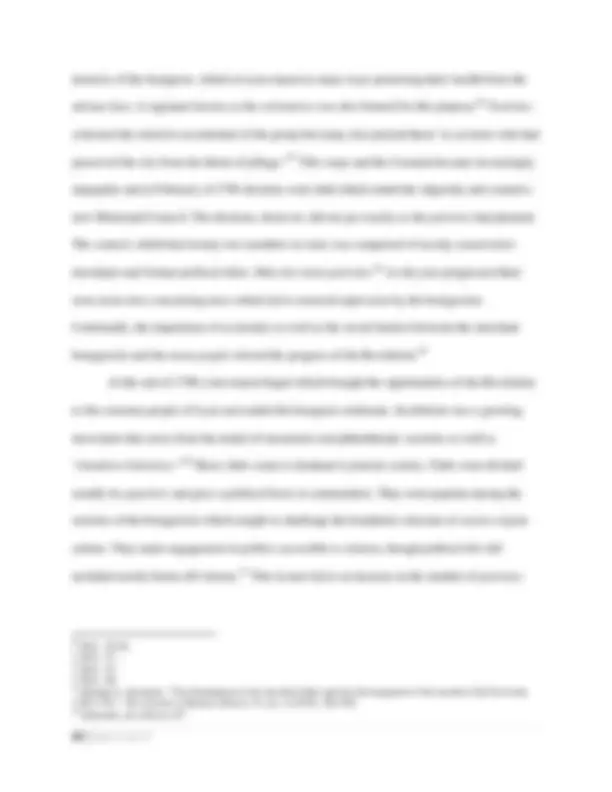

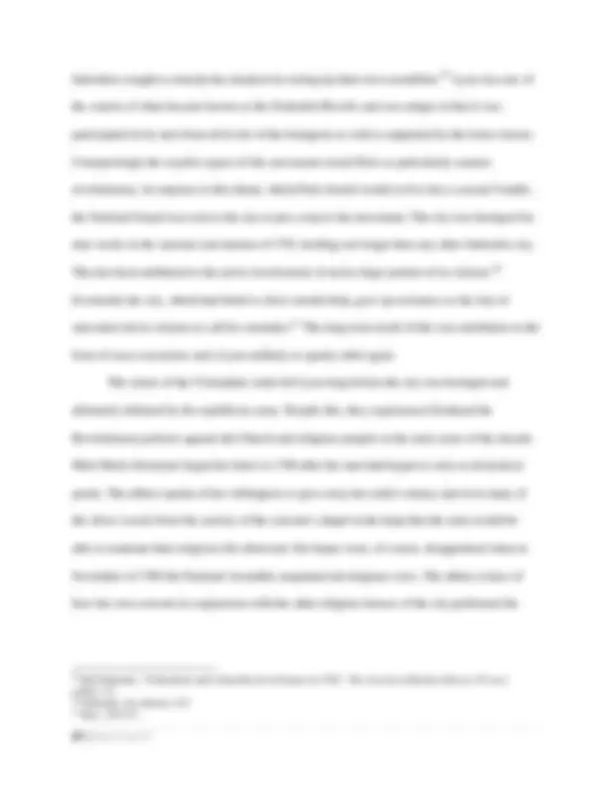
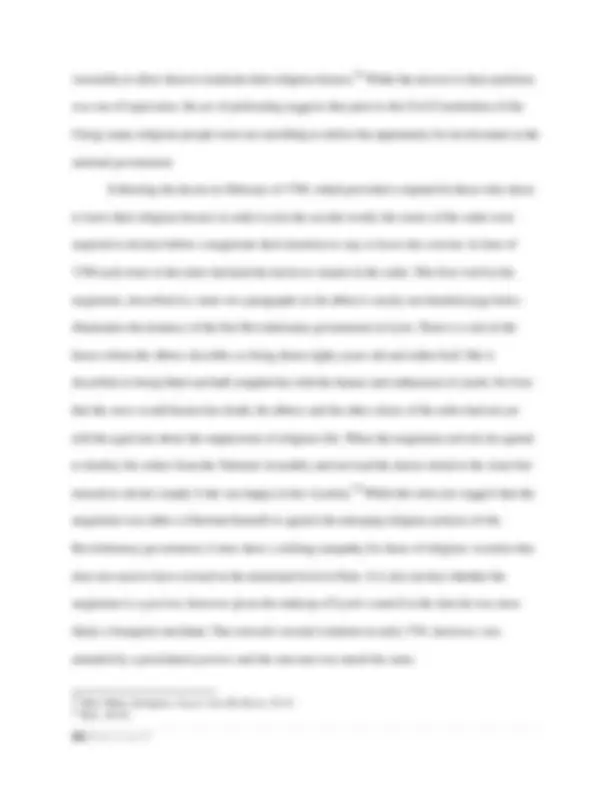
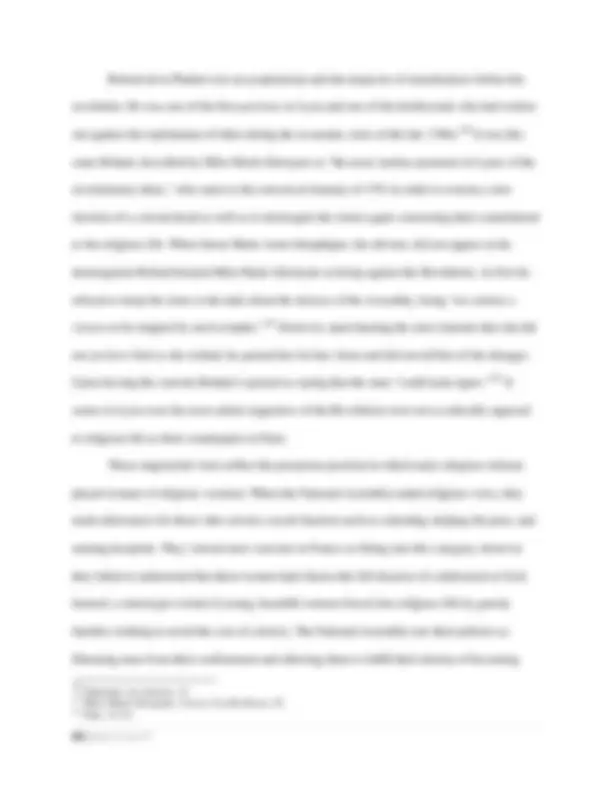
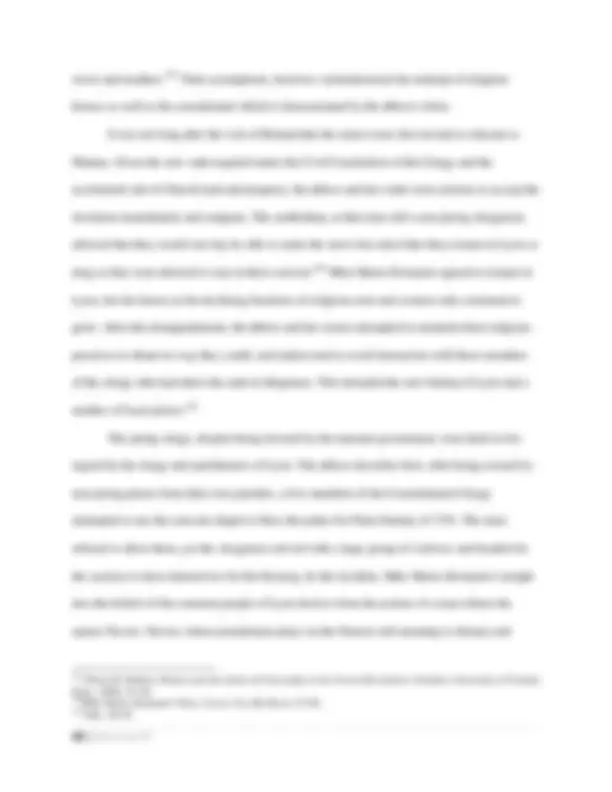
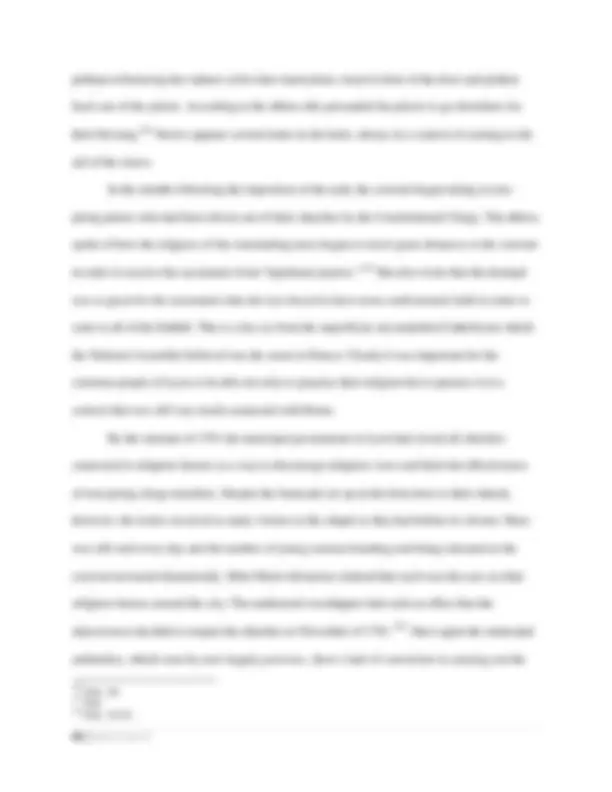
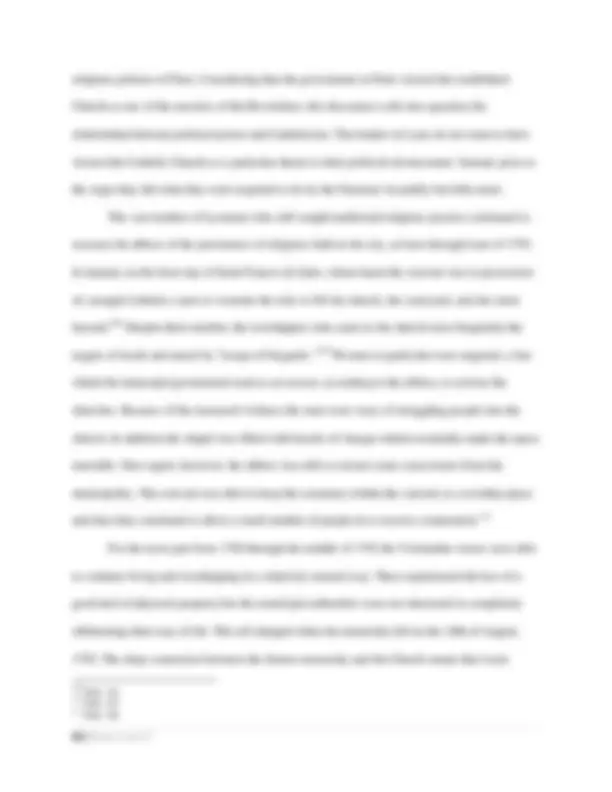
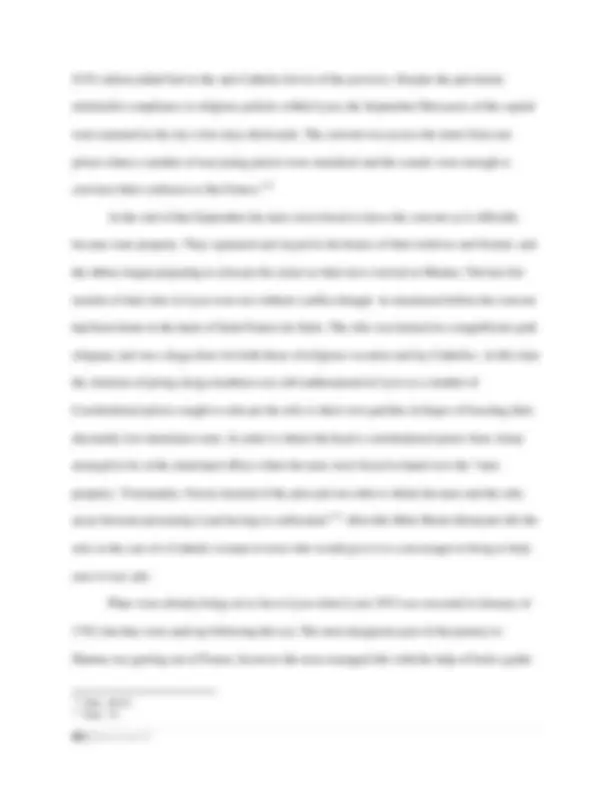
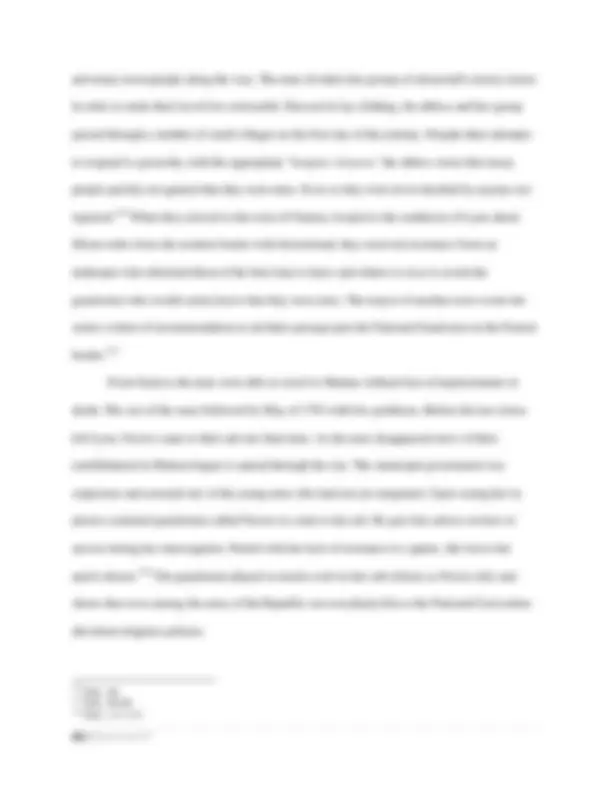
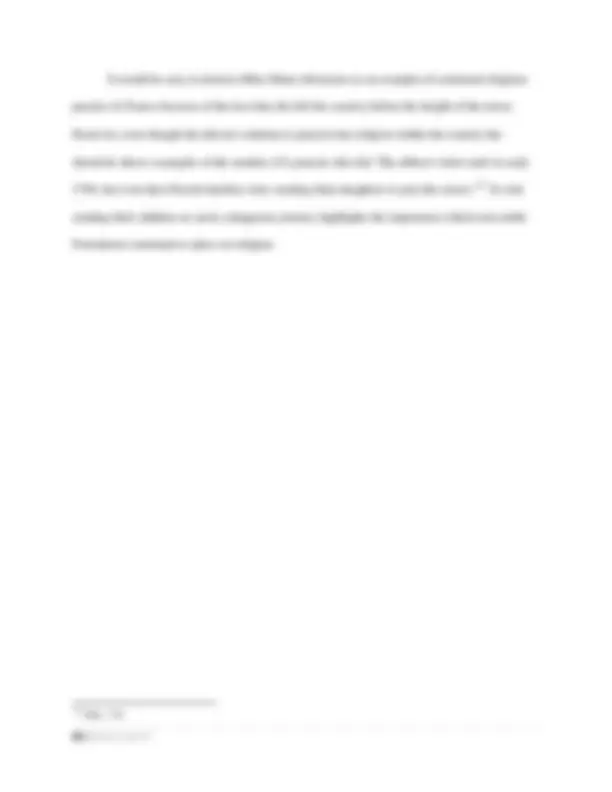
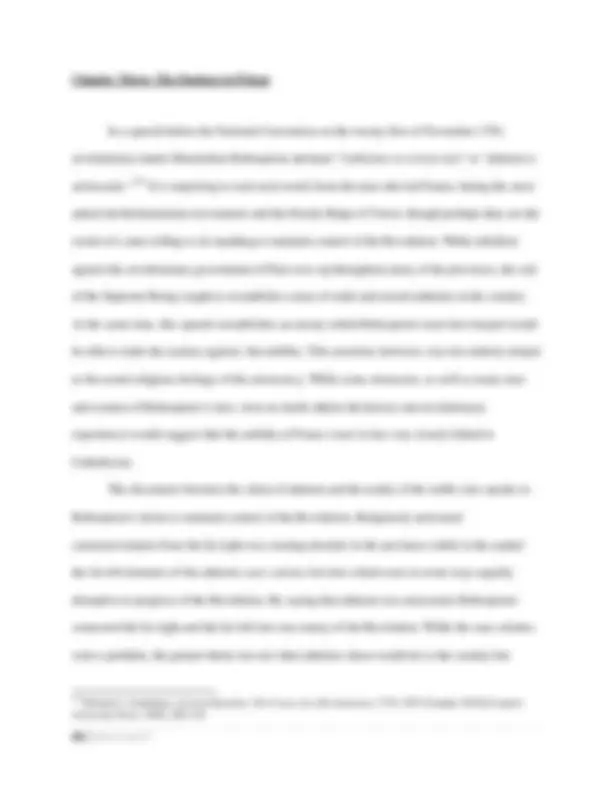
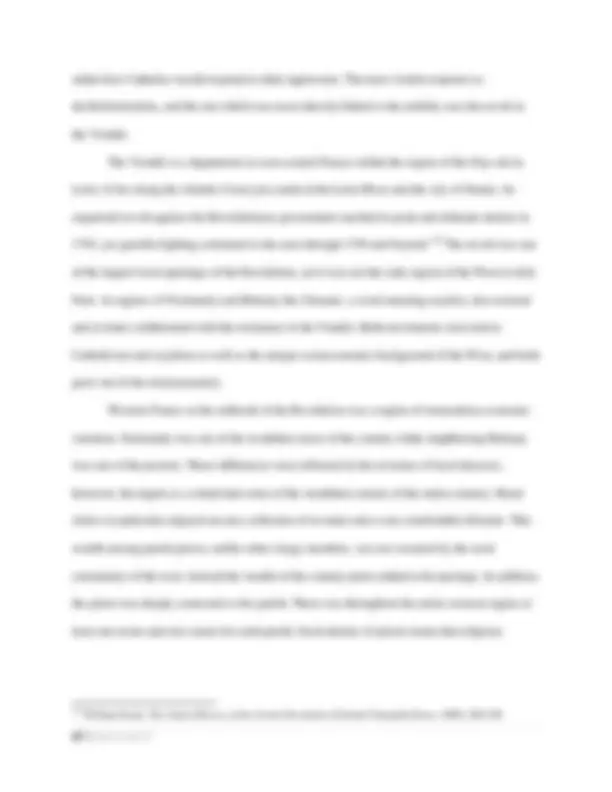
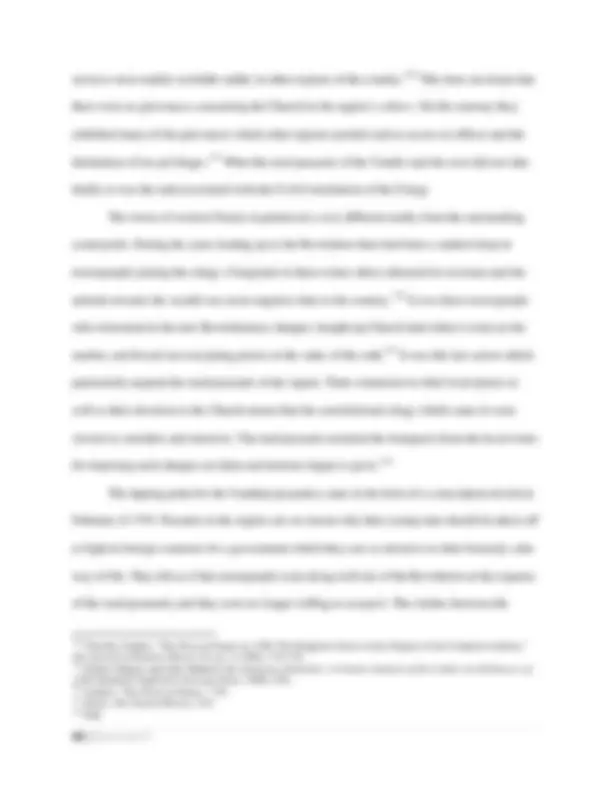
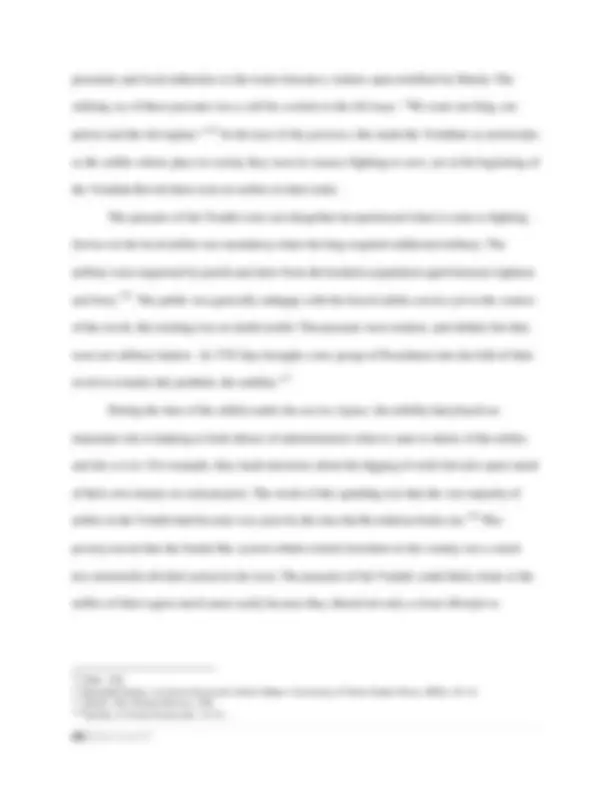
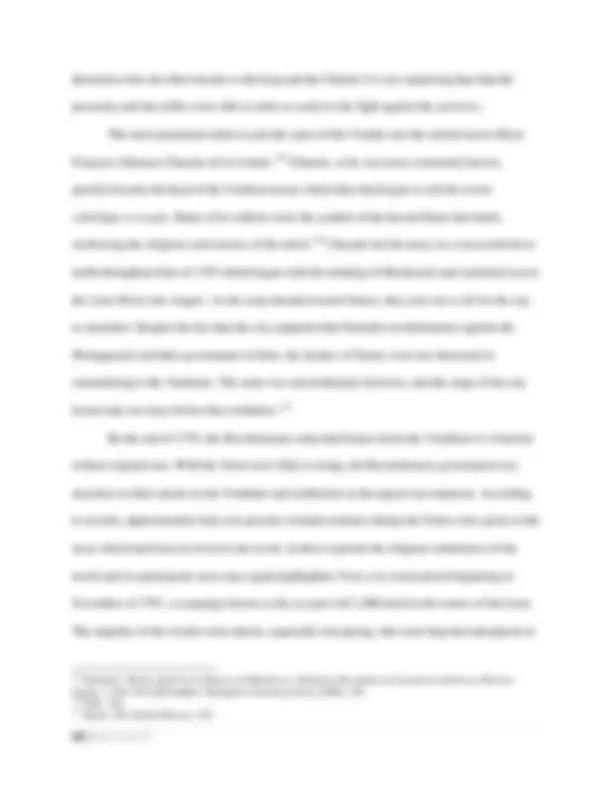
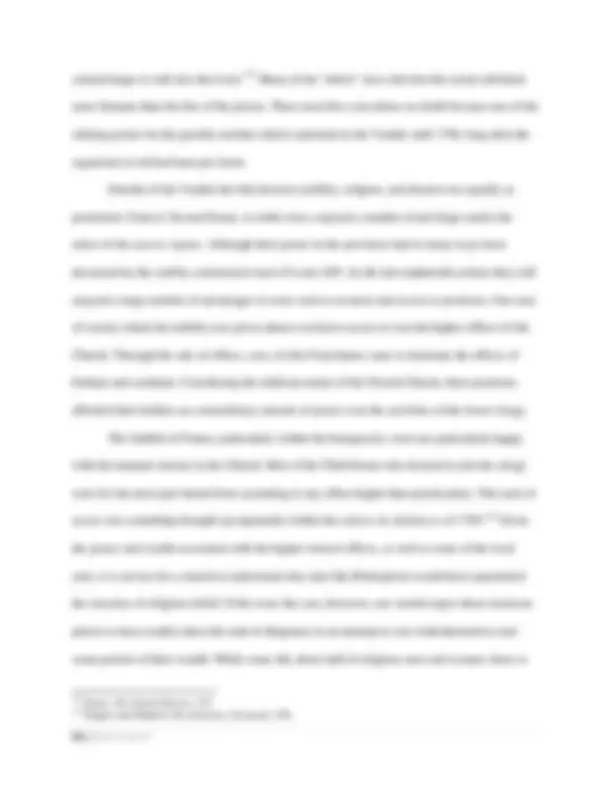
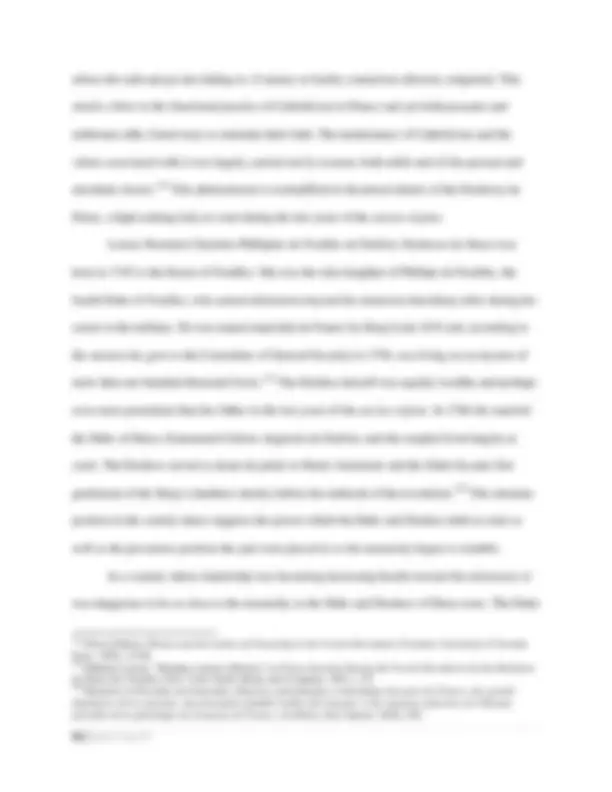
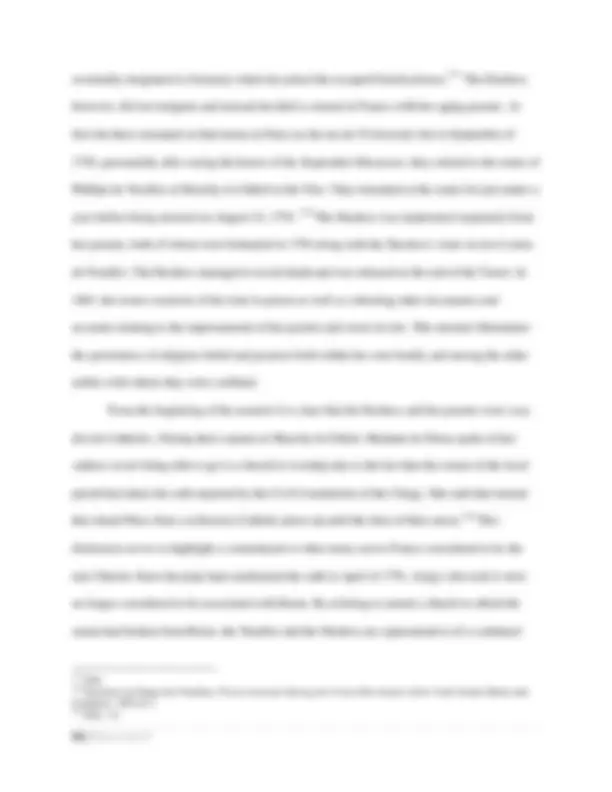
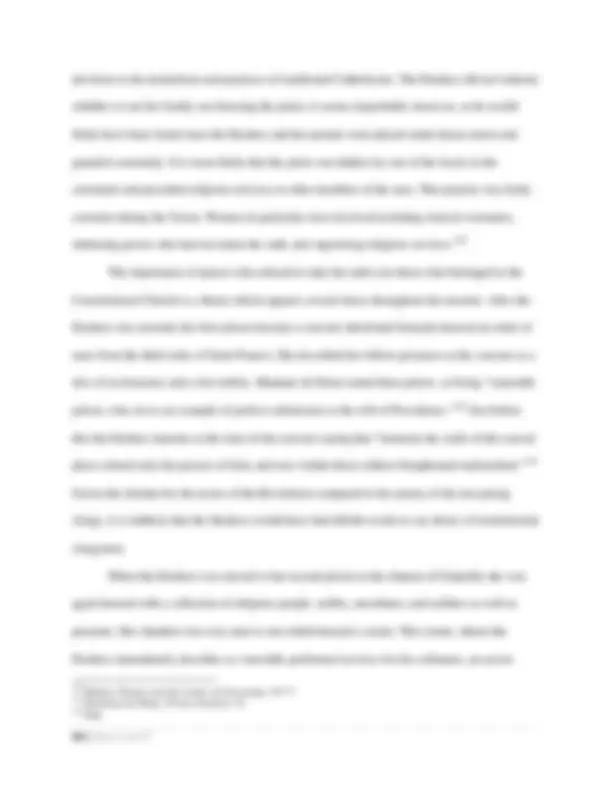
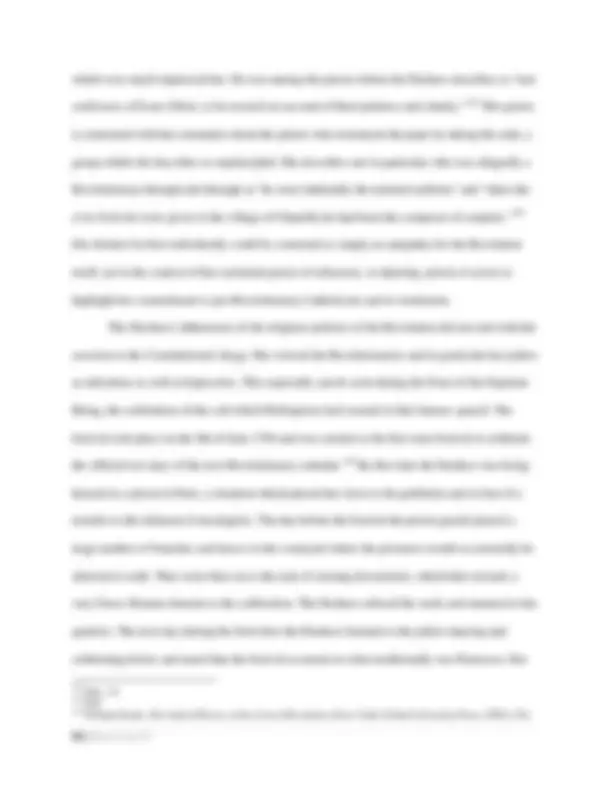
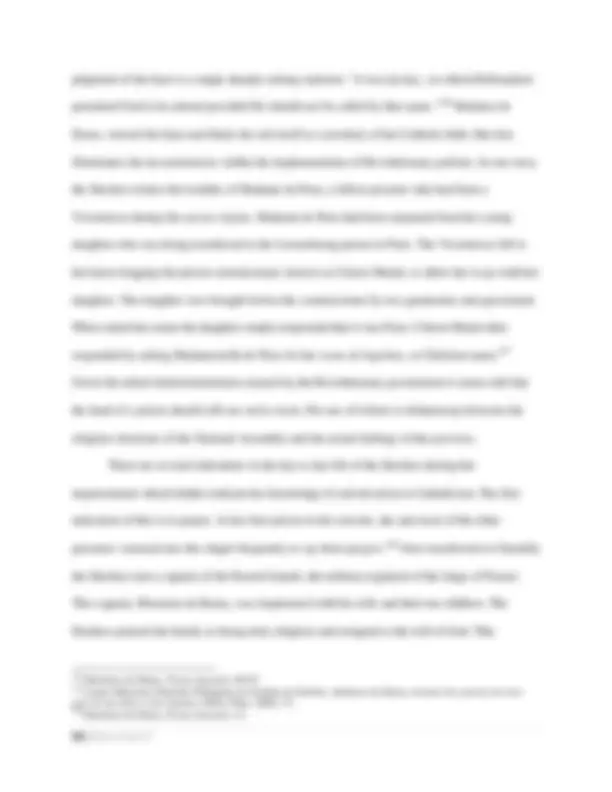
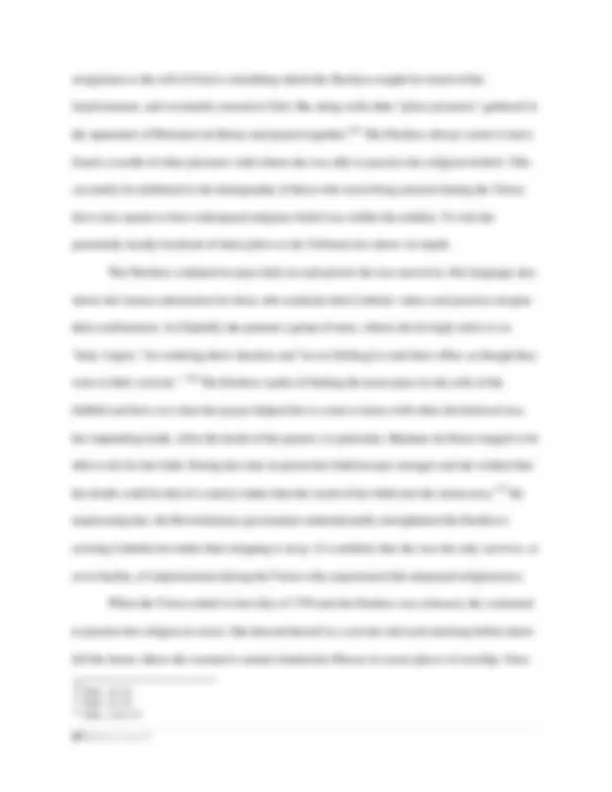
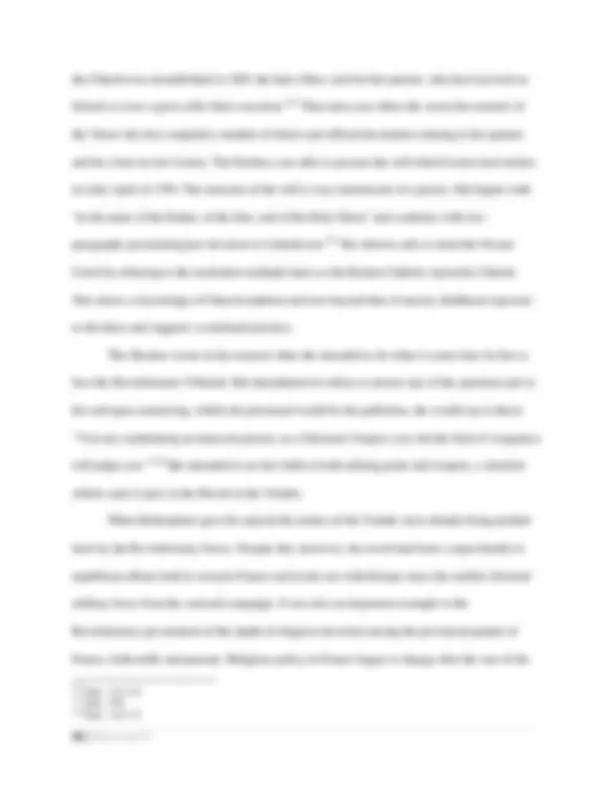
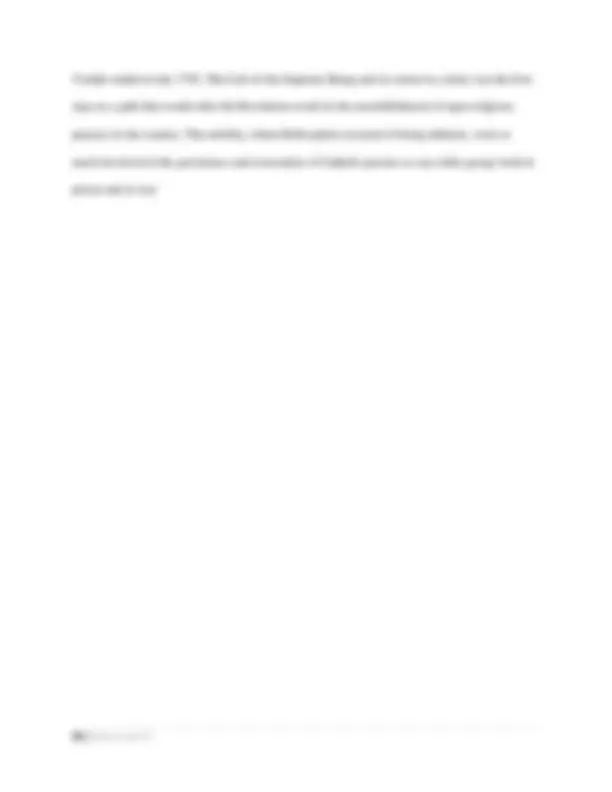
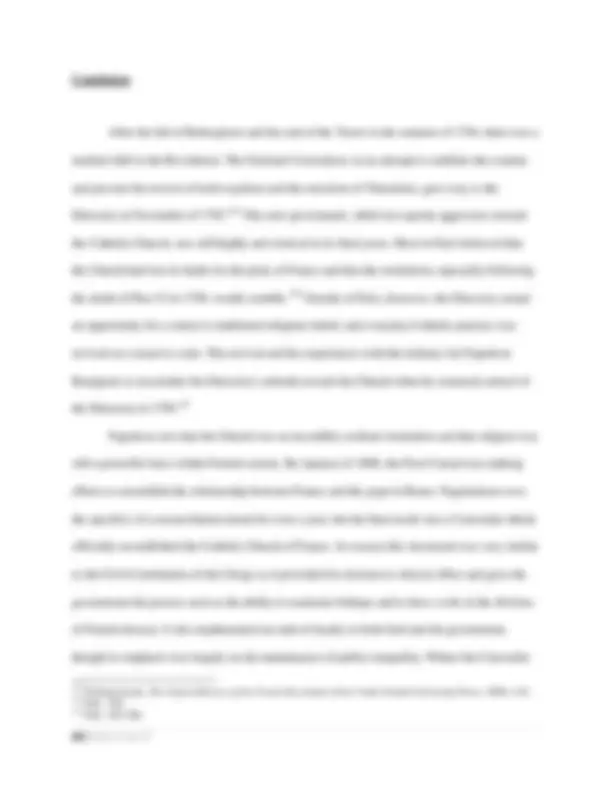
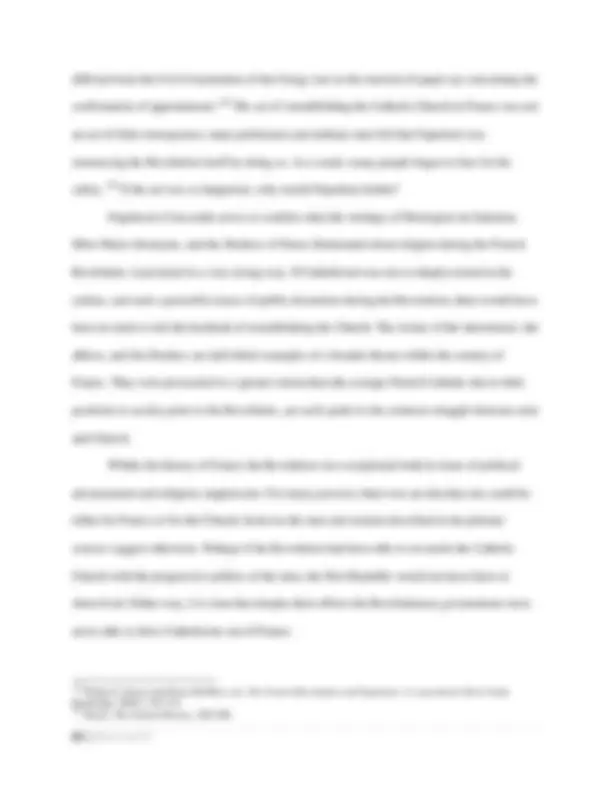
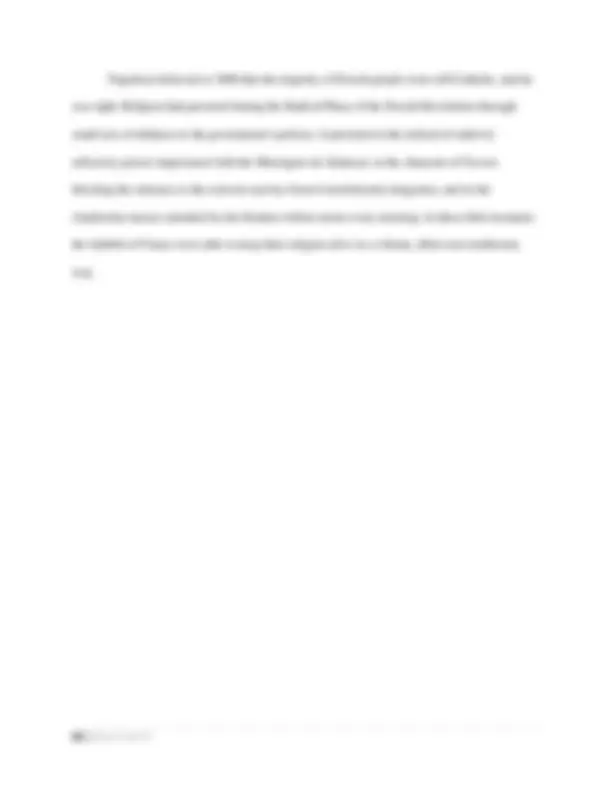
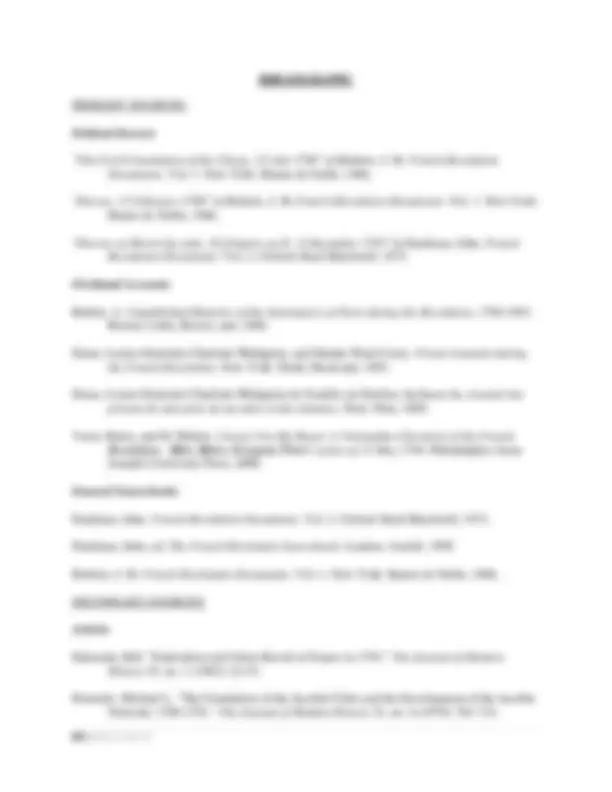
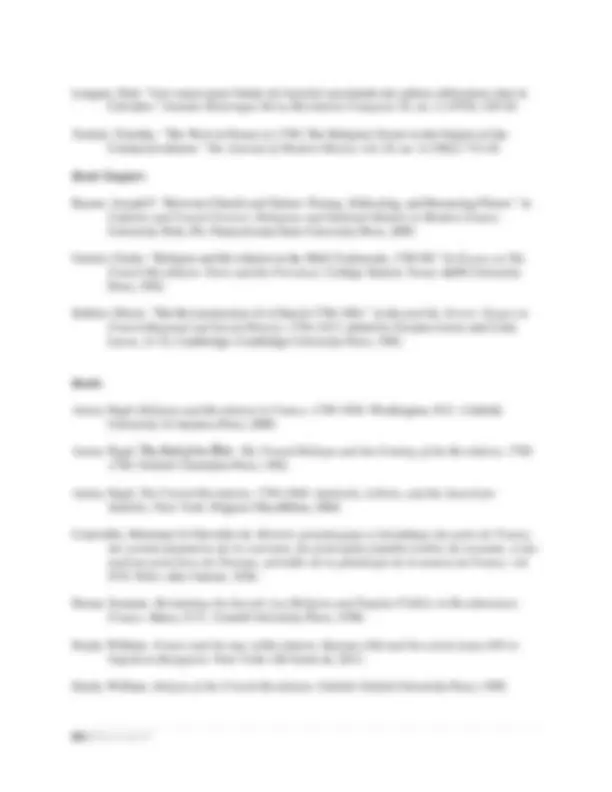
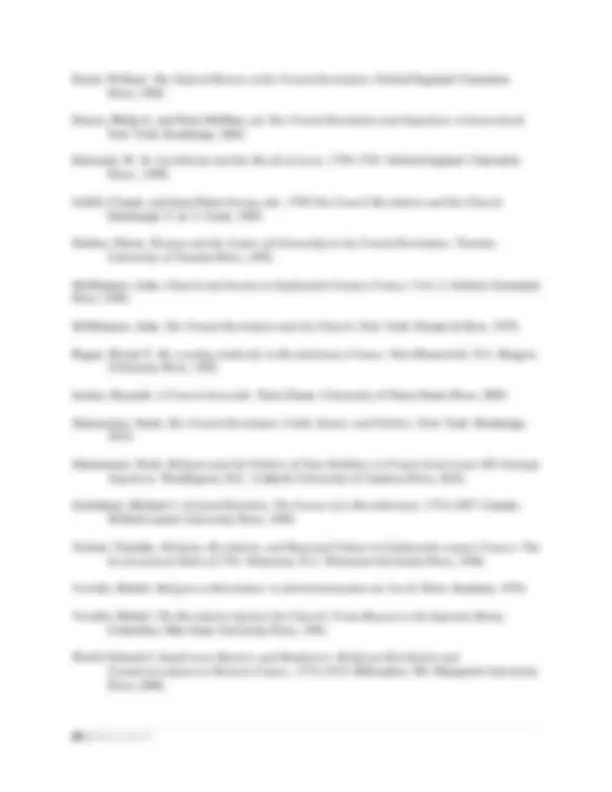


Study with the several resources on Docsity

Earn points by helping other students or get them with a premium plan


Prepare for your exams
Study with the several resources on Docsity

Earn points to download
Earn points by helping other students or get them with a premium plan
Community
Ask the community for help and clear up your study doubts
Discover the best universities in your country according to Docsity users
Free resources
Download our free guides on studying techniques, anxiety management strategies, and thesis advice from Docsity tutors
The deep-rooted connection between France and the Church during the French Revolution. Through the analysis of three eyewitness accounts, it illustrates the persistence of religious belief in France despite measures against religious practice. The document also discusses the significance of the Schism Papacy's decision to establish a court in Avignon and the impact of the Huguenot conversions. Furthermore, it examines the religious grievances expressed in the cahiers and the response of the clergy to the Revolution.
Typology: Study notes
1 / 65

This page cannot be seen from the preview
Don't miss anything!


























































UNIVERSITY OF COLORADO
Maura Kalthoff 4/1/
Advisor: Martha Hanna, Department of History Honors Council Representative: Fred Anderson, Department of History Committee Member: Alina VanNelson, Department of French and Italian
Abstract: This thesis explores expressions of Catholic belief and practice during the Radical Phase of the French Revolution. Religion was one of the most contentious issues of the Revolution and the government's treatment of it was one of the major causes for popular discontent and even counterrevolution. As the Revolution turned more radical it became more dangerous to follow traditional Catholicism, yet dechristianization did not end its practice. The goal of this study is to understand the ways in which French men and women were able to maintain their faith despite the government's increasingly hostile approach to dealing with religion. It utilizes three main primary sources from individuals of varying social class and circumstance to illuminate the struggles of Catholics throughout France during this time of upheaval. Overall this study will show that through small acts religious practice was able to withstand state-sanctioned suppression.
Introduction
From its beginnings in 1789, one of the major issues of the French Revolution was that of religion. It was an issue which appeared in nearly all cahiers de doléances , the documents of grievances drawn up by the members of the Estates General. When the National Assembly was formed the issue of the Church was almost immediately approached. In 1789 the body decreed that Church land would become property of the state to use at it saw fit. Later that year the Assembly prohibited religious vows, offering stipends to those who decided to leave their religious houses to rejoin French society. This was paired with a push for former religious men and women to marry each other in order to fulfill what was seen as their natural destiny. In 1790 the National Assembly restructured the French Church into a more egalitarian system based on the election of priests and bishops as well as turning the salaries of the clergy from a private, Roman issue to the responsibility of the government. This act was similar to others in Europe around this time, however the act became controversial the following year when an oath of allegiance to the National Assembly became required for all clerics. The controversy over the act led to a schism between the Constitutional clergy who took the oath and the refractory clergy which abstained. These non-juring priests would later become subject to decrees subjecting them to deportation and the victims of incredible violence in the September Massacres and the later Terror. Under the National Convention attempts to restructure the Church would turn to aggression against Catholicism. Religious practice was outlawed and replaced with the Cult of the Supreme Being, a deist state religion. The state eventually turned against its own Constitutional Church and while measures against religious practice would lessen
under the later Directory, the Catholic Church in France would not be reestablished until the Concordat of Napoleon in 1801. In the context of the rapid shift from restructuring Catholicism to driving its practice out of France, the question of reality versus the laws of the national government in Paris becomes extremely important. While the various assemblies were slowly dechristianizing France, what was really going on for the country's people? That is a question this thesis seeks to ask. I will explore whether or not Catholic practice was in some sense able to continue despite the dechristianization attempt made by the Revolutionary governments. This thesis does not seek to determine whether or not the dechristianization movement which existed in France during the Radical Phase of the revolution, 1792-1794, was successful. A definitive answer to that question would take years buried in archives and may never be able to be resolved as each town and region had its own political and socioeconomic context which resulted in the movement's ability to take hold. Instead this paper will show that some religious practice did continue and explore the ways in which these beliefs and practices were able to persist during this Radical Phase. Through analysis of three eye witness accounts of the Revolution, I hope to illustrate that the depth of religious belief ran deeper in France than those in power might have wished. To begin with, it is necessary to consider how the history of power and society in France was intricately linked with the history of Catholicism. In the year 800 Charlemagne became the first French king to be coronated in a ceremony called a sacre , a name which itself suggests a deep connection between religion and political power. During these ceremonies, which were usually held in the cathedral of Reims, the king swore a coronation oath that began with an
next decade with several clashes across the country as well as the infamous St. Bartholomew's Day massacre.^8 Fighting subsided for many years until Henry of Navarre, a Protestant, was made heir to the throne in the mid-1580s. He ascended the throne in 1589 and in 1593 essentially ended the Wars of Religion by converting to Catholicism and, five years later, issuing the Edict of Nantes. This decision to convert to Catholicism in order to bring peace to France illustrates just how deep the ties to the Church were in country. Politically, Henry needed the Church in order to legitimize his claim among the Catholic League as well as abroad. According to historian Mack P. Holt, however, this conversion was also part of a broader plan to establish lasting peace in the country by creating a country once again unified by religion.^9 If this was the case, his choice of Catholicism must have spoken to more than just the religion of the powerful nobility but to that of the commoner class as well. This desire to reunify France religiously was never realized in the nearly two centuries which elapsed between the Edict of Nantes and the outbreak of the French Revolution. During the first part of the seventeenth century the Huguenots, or French Protestants, were protected under the Edict which had given them unprecedented civil and religious liberties. These liberties were hindered somewhat when Cardinal Richelieu signed the Peace of Alais in 1629, rescinding the military rights given to them by Henry IV.^10 The dismantling of the Edict continued with greater enthusiasm during the reign of Louis XIV. During a number of sweeps across the Huguenot areas of southern France, there was moderate success in conversion. This convinced the king that he could triumph over the "heresy" of Huguenot Calvinism prompting him to issue
(^89) Ibid., 81-95. 10 Ibid (^) Geoffrey Adams,. , 156. The Huguenots and French opinion, 1685-1787 (Canada: Canadian Corporation for Studies in Religion, 1991), 7.
the Edict of Fontainebleau in 1684, rescinding the rights previously granted to Protestants by the state.^11 Following the Edict many Huguenots decided to convert but a large number also chose to emigrate. Persecution ebbed following the death of Louis XIV and in a 1787 Edict, the young Louis XVI restored rights to the group.^12 The history of religious tension in France, while turbulent, is also suggestive of just how deeply the roots of Catholicism ran among the French people. In each religious conflict from the Wars of Religion to the revocation and reinstitution of the Edict of Nantes, it is clear that the dominant side was that of the Catholic Church. It is this resistance to decline which makes the intense dechristianization programs implemented by the various governments during the French Revolution, particularly during the Reign of Terror, such an anomaly. Although it is clear that the religious tradition most widely ascribed to in the time leading up to the revolution was Roman Catholicism, that is not to say that there was no division within French practice of Catholicism itself. In fact, some of the political policies of the revolution came out of theological debate within the religion. In the mid-seventeenth century a cult within the Catholic Church rose up around the ideas of the Bishop of Ypres, Cornelius Jansen. Citing the works of St Augustine, Jansen claimed that people were in fact already fated for either salvation or damnation.^13 The established Church viewed these ideas as too similar to Calvinism and thus deemed heretical. Jansenists, on the other hand, disagreed claiming that they were in no way separate from conventional Catholicism.^14 While this ultimately was true, during the century and a half preceding the French Revolution the
(^1112) Ibid., 7-8. 13 Ibid., 295-304.William Doyle, Jansenism (New York: St. Martin's Press, Inc.), 1. (^14) Ibid., 1.
affairs of the local clergy; a fact they greatly resented. On top of that the king once more influenced papal intervention in the Jansenist problem.^19 At the start of the eighteenth century the prominence of Jansenism within France seemed to be dwindling, at least as a religious practice. Old Jansenist leaders began to die off and they were replaced by a younger generation of clerics who agreed with the claim of heresy first put forth by the Jesuits nearly a century before.^20 Before their death knell, however, they both brought an end to the Jesuit order in France and left a lasting impact on French politics. During the height of their persecution under Louis XIV, the Jansenists had begun to question what created political legitimacy. In the early 1750s it became a practice among the clergy to deny last rites to those who could not produce a confession note signed by the priest to whom they had last confessed. This was used against many Jansenists in Paris, to the horror of many who saw it as clerical despotism. When complaints about the practice were taken before the king he frequently acted to prevent the parlement from interfering. Eventually the king did communicate with Rome to ban the practice of refusing last rites, but the newly prominent Jansenists were already beginning to consider whether the king should have the ability to prevent the parlement from acting.^21 When the Revolution began, this was one of the essential questions. The conflict surrounding Jansenism also foreshadowed in many ways the desire of the French government to separate itself from the influence of Rome and to limit the powers of the king over the parlements. The French Revolution was, nonetheless, the end of Jansenism as it was often blamed by those who were startled at its rapid acceleration. As a result when religious practice
(^19) Ibid_._ , 42-46. This bull was known as Unigenitus and infringed upon the traditional liberties of the Gallican Church. When it was first introduced many members of the clergy, both Jansenist and not, were ardently opposed toit. By the 1740s this opposition had for the most part died out. (^2021) Ibid., 50-54. Ibid., 62-64.
began to resurface in France following the dechristianization of the early Revolution, Jansenism was no longer a factor.^22 When King Louis XVI summoned the Estates General to meet in 1789 there was little thought in the minds of those who were elected to the assembly about the bloody revolution which would engulf France over the following decade. Examining the cahiers de doléances which were brought to the assembly by each representative, the demands they put forth were hardly revolutionary compared to the events which followed. According to a study done by Gilbert Shapiro and John Markoff, the vast majority of local cahiers in 1789 focused on greatly equality between the Third Estate and the first two, particularly in regards to taxation and social mobility. The study shows that the Third Estate hoped to abolish tax privilege for the Nobility and the Clergy, create a standardized taxation system, and gain access to careers which had previously been off limits to them such as the military and administrative offices.^23 They also had a number of grievances concerning the Church. In regards to the religious culture of France the cahiers make it clear that the French in general were interested in returning to a more Franco-centric, yet still Catholic, Church. There were six sets of religious grievances which appear in the collected cahiers : a demand for the end of clerical privilege, secularization of several social institutions, full or partial state control of Church property, the end of legal and fiscal prerogatives of the papacy within the French Church, expanded religious toleration, and greater power given to local parish clergy.^24 While many of these desires suggest a move away from the Church, they are more indicative of a move away from papal interference than an abandonment of Catholicism. As the country moved toward the
(^2223) Ibid., 72-85. 24 Gilbert Shapiro and John Markoff,Timothy Tackett, "The West in France in 1789: The Religious Factor In The Origins of Counterrevolution," in^ Revolutionary Demands^ (Stanford: Stanford University Press, 1998), 258, 312. Revolutionary Demands , Gilbert Shapiro and John Markoff (Stanford: Stanford University Press, 1998), 338.
with folk traditions without drawing the disapproval of the Church hierarchy.^27 The desire merely to reform the pre-existing structure of a well accepted religion over time transformed into dechristianization; a process which went hand in hand with the downfall of the monarchy. For the Revolutionary leaders who arose in the early years of the decade, the end of the Ancien Régime meant an end to its excesses. As Louis XVI's power waned, the disdain of the Montagnards towards the monarchy increased exponentially. While the original authors of the Revolution sought to create a constitutional monarchy like that of England, the hesitations of the king to accept reforms as well as his disastrous Flight to Varennes in the summer of 1791 proved that no such government could truly be established. Since the monarchy's power was historically so linked with that of the Church, it is little surprise that the revolutionaries also began to attack this institution. In 1790 the Civil Constitution of the Clergy was passed, creating a more Gallican organization of the Church which aligned with the ideas of the cahiers. It redrew the lines of diocese to match those of the administrative divisions, allowed for election of bishops by the priests of the country, and established clergy salaries to be paid by the government rather than by Rome.^28 While many of the bishops were unhappy with the changes, other clerics supported the early reforms of the Church. The Civil Constitution of the Clergy was not, like later legislation, meant to destroy the Catholic Church within France. The ecclesiastical committee which created it was largely comprised of devout Catholics who sought to align it with the ideas of Revolution while purging it of its excesses. It did, however, concern those Catholics who were already startled by earlier decrees calling for the confiscation of Church property and the prohibition of monastic vows.
(^2728) Shusterman, The French Revolution , 11. Byrnes, Catholic and French Forever , 5-6.
The turning point of religious policy in the Revolution was not these early reforms, but rather the Ecclesiastical Oath of 1791. The idea of an oath was first posited in the Civil Constitution of the Clergy, though it had been intended only for any new clergy who would be elected in the future.^29 By mid-1790, however, the National Assembly was becoming increasingly polarized over the new religious policies. There were calls to require an oath of allegiance to the Civil Constitution and the Assembly despite loyalty oaths having already been made by those clergy who joined the Assembly in 1789. Before the oath was enforced, the seeds of discomfort were already blossoming among the people of France and the clergy.^30 While many claimed that the Assembly had no desire to attack the spiritual authority of the Church, many clergymen were uncertain that this was the case. Revolutionaries such as Mirabeau pushed forward an amendment in the Assembly calling for "pure and simple" oaths with no ambiguity. In addition the pope issued a condemnation of the oath and the Civil Constitution itself. This made the question of loyalty black and white: you were either with the revolution or with the pope.^31 It is this event which historians such as William Doyle and Timothy Tackett have identified as the turning point for religion in the Revolution and for the Revolution as a whole. It forced both clergy and the common citizen to question whether they could fully support the new order in France.^32 For many of them the answer was no. As the Revolution became increasingly radical under the leadership of Robespierre the government's campaign against the Church became increasingly more zealous. Events such as the September Massacres of 1792, the dissolution of the Constitutional Church, and the
(^29) "The Civil Constitution of the Clergy,” in The French Revolution Sourcebook , ed. John Hardman (New York: Oxford University Press, 1999), 115-116. (^30) Timothy Tackett, Religion, Revolution, and Regional Culture in Eighteenth-Century France: The Ecclesiastical Oath of 1791 (^31) Ibid., 25-26. (Princeton: Princeton University Press, 1986), 16-24. (^32) William Doyle , The Oxford History of the French Revolution (New York: Oxford University Press, 1989), 144-
the Catholic Church. It laid important groundwork for the religious issues which were involved in driving France toward Revolution. Not long after McManners' book, French Historian Michel Vovelle published Religion et Révolution: la déchristianisation de l'an II.^34 While focusing on the southeast of France, Vovelle looked at the effort to dechristianize and how it spread throughout the area. His sources include clerical records, reports, and speeches. Vovelle's argument seems to be that the success of dechristianization was something very localized and that the movement tended to predate the Revolutionary period. This idea then suggests that more conservative regions saw less dechristianization while more progressive regions were predisposed to a move away from religion. He argues that the decline in monetary gifts being left to the Church in wills during the mid-eighteenth century shows that Catholicism was already on the decline. Historians over the past several decades have sought to determine whether dechristianization was an inevitable process accelerated by the radical policies of the Revolution and if it was not was the movement to dechristianize France successful. Vovelle's book established one side of this debate which, further asserted by his second book in 1991, has continued to see some support from other scholars such as Noah Shusterman. Shusterman, while admitting that certain forms of Catholic practice were still very visible in the secular world of Ancien Régime France, states that there was a marked decline in Catholicism in the lead up to the Revolution.^35 The main evidence for this argument comes from records concerning the distribution of money after death as well as drawing heavily on the rates of ecclesiastical abdications throughout the country.^36
(^3435) Michel Vovelle, Religion e : l de l'an II. (Paris: Hachette, 1976), 9-15, 285-300. 36 Shusterman,Michel Vovelle,^ The French Revolution The Revolution against the Church , 13. (Columbus: Ohio State University Press, 1991), 1-11.
The opposite side of this debate suggests that dechristianization was successful in certain places not because of some geographic determinism but rather based on the specific situation of each individual town. It also suggests that secularization does not mean dechristianization and asserts the roots of Catholicism ran deeply enough in the culture of the French people that the success of the movements was not as spectacular as it would appear. One of the founding scholars on this side of the debate is Suzanne Desan. In her 1990 book, Desan used the department of Yonne, not far from Paris, to show that pro-Revolutionary feeling and a desire to maintain religion were not mutually exclusive ideas. Yonne in the early revolution had a Jacobin club and welcomed the Revolution and its religious policies as a way to integrate folk practices into their practice of Catholicism.^37 The people of the region were religious outside of their relationship to the clergy. They celebrated religious days and mass, and women played a crucial role in the continued demand for worship. This focus on the relationship between gender and religion was further explored in the second section of Olwen Hufton's 1992 Women and the Limits of Citizenship in the French Revolution.^38 Other historians whose work places them on this side of the debate include Timothy Tackett, Edward J. Woell, and Nigel Aston. The first chapter of the paper will use the memoirs left behind by the papal envoy to Paris in the early years of the Revolution. Imprisoned along with many other religious figures, the internuncio's political position within the clergy provides insight into the ways in which the situation of Paris escalated to the point of the September Massacres and the threat of the guillotine in the months following. He also recounts experiences which suggest that not even all the patriotes of Paris were necessarily in agreement with the policies of their leaders.
(^3738) Suzanne Desan, Reclaiming the Sacred (Ithaca: Cornell University Press, 1990), 25. Olwen Hufton,Press, 1992). Women and the Limits of Citizenship in the French Revolution (Toronto: University of Toronto
Chapter One: The Internuncio of Paris
The oath of loyalty which was added to the Civil Constitution of the Clergy in 1791 was an incredibly divisive issue among the clergy of France as well as the common people and those religious men and women who were not required to take the oath. As demonstrated in the previous chapter, many Catholics distrusted the juring clergy due to their willingness to defy the Pope's condemnation of the oath. Initially, between fifty-two and fifty-five percent of parish clergy decided to take the oath. By 1792 a fair number of clergymen had retracted their oath, yet the percentage of juring clergy remained at about forty-nine percent.^39 Those who refused to take the oath became known as refractory or non-juring priests. In 1791 these clergymen were largely driven out of their parishes, not able to perform Mass, and sometimes accosted on the streets. As the political climate in Paris became more radical, however, to be a refractory priest became increasingly dangerous. In the infamous September Massacres of 1792 it was not the Constitutional Clergy which was attacked, though their persecution would come eventually. Instead it was the refractory clergy along with many other victims who happened to have found themselves imprisoned during the summer of 1792 who were slaughtered in prison. A firsthand account of these massacres is found in the memoirs of Monsignor de Salamon. Monsignor de Salamon was only about thirty years old when the Revolution began in 1789, yet he had already established himself on a national and international level. He was born in Italy but was sent to France to continue his studies at an oratory in Lyon.^40 He was made a priest at the age of twenty-two by papal dispensation and also became a magistrate and was a member
(^39) Timothy Tackett, Religion, Revolution, and Regional Culture in Eighteenth-Century France: The Ecclesiastical Oath of 1791 (^40) Monsignor de Salamon, (Princeton: Princeton University Press, 1986), 40-43. Unpublished Memoirs of The Internuncio at Paris During the Revolution, 1790-1801 , ed. Abbé Bridier (Boston: Little, Brown, and Company: 1896), 37-38.
of the Parlement of Paris between 1787 and 1789.^41 These experiences allowed him an understanding of the declining status of the clergy and the royal family within the capital as France moved towards Revolution, yet his indebtedness to the Pope made him unable to refuse the appointment of internuncio to Louis XVI in 1790.^42 He never took the ecclesiastical oath and at the end of August 1792 the internuncio was arrested and imprisoned with other religious men. He managed to escape the massacres unharmed, yet still was forced to live in hiding until the end of the Terror. His experiences reflect those of many refractory priests throughout France and reveal the availability of help for non-juring clergy, even within Paris itself. The Civil Constitution of the Clergy was largely accepted when it was first put forth in early 1790. It called for the redrawing of bishopric boundaries to match those of the departments and the election of priests to ecclesiastical office. A clause declared that the elected bishops may not ask the Pope for confirmation but need not break ties with him "in token of the unity of faith and of the communion he should maintain with him." The constitution also called for newly elected clergymen to swear an oath to "care for the faithful of the diocese which is entrusted to him, to be faithful to the nation, to the law and to the king and to maintain with all his power the constitution decreed by the National Assembly and accepted by the king. 43 This oath was not asking a particularly difficult thing of the clergy and did not apply to the vast majority of clergymen as they were already in office.^44 By the end of 1790 the National Assembly decided to expand the oath of allegiance to the constitution to all clergy members, whether new or incumbent. This was paired with the promise to remove all those who refused to take the oath within one week from their positions. The
(^4142) Ibid., 6-7. 43 Ibid"The civil constitution of the clergy," in_._ , 5-8. The French Revolution Sourcebook , ed. John Hardman (London: Arnold, 1999), 115-116. (^44) Tackett, Religion, Revolution and Region Culture , 18-19.